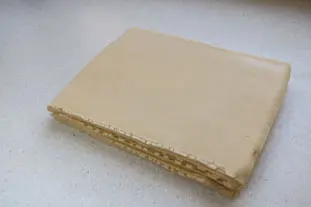Yeast-based flaky dough (for croissants)
A recipe from cooking-ez.com June 9th 2019177 K 43.9
For 1 kg 400 g, you will need:
- 1 110 ml water
- 2 100 ml whole milk
- 3 50 g egg ( How to... )
- 4 500 g plain white flour (French Type 45)
- 5 9 g fine (or table) salt
- 6 70 g caster sugar
- 7 25 g yeast
- 8 10 g honey
- 9 30 g butter
- 10 100 g fermented viennoiserie dough
- 11 50 g leaven (optional)
- 12 300 g butter
- Total weight: 1,305 grams
Times:
| Preparation | Resting | Start to finish |
|---|---|---|
| 60 min. | 3 hours | 3 hours 60 min. |
Step by step recipe
- 1: Put into a jug: 110 ml water, 100 ml whole milk and 50 g egg. Refrigerate overnight, or for at least 2 hours.
We need to do this (as for all viennoiserie doughs) because we need to work with very cold ingredients. - 2:
Basic dough
Pour the water+milk+egg mixture (really cold) into a mixer bowl, then add 50 g egg, 9 g fine (or table) salt, 70 g caster sugar, 25 g yeast, 10 g honey, 30 g butter, 100 g fermented viennoiserie dough and 50 g leaven. - 3: Knead on slow speed for 8 minutes, then on slightly higher speed for 10 minutes.
Note: For the best way to knead, see: A few tips for effective kneading at home. - 4: You should now have a supple, firm dough.
- 5: To be sure the dough is well-enough kneaded, do the window-pane test. If it isn't ready, knead for a little longer.
- 6: Tip out the dough onto a floured worktop.
- 7: Shape the dough into a long roll, as shown in this short video.
- 8: Cover the dough with plastic sheet and leave to rest for 15 minutes.
- 9: After this time, roll out the dough with a rolling pin into a large rectangle, the same size as your oven shelf, and lay it on this.
Lay a plastic sheet on top and put the lot into the freezer for 45 minutes to thoroughly cool the dough. - 10: Meanwhile, prepare the 300 g butter: wrap it in plastic sheet and hit with a rolling pin until it is the same height as the rectangle of dough, but only half as wide.
- 11: Once you have the right sized rectangle, put the butter to wait in the fridge.
- 12:
Layering with butter
Check that the dough and butter are at about the same temperature, i.e. very cold (this is most important). Lay the dough on the worktop.
Take the rectangle of butter out of its plastic wrapping and lay on the dough. If you have measured correctly, the butter should cover half the width of the dough and its full height. - 13: Fold the sides of the dough over the butter. The edges should meet in the centre to completely cover the butter.
- 14: With the rolling pin press over the whole surface to spread out the butter on the inside.
It doesn't matter if a little butter squashes out at the ends. - 15: So, at this stage we have one layer of butter sandwiched between 2 layers of dough, as in this diagram (yellow = butter, brown = dough).
- 16: Roll out the dough lengthways to about 24 inches (60 cm).
I admit this is hard work; it takes a lot of energy to roll out a firm dough. - 17:
The double turn
Fold the dough ends in, but not into the centre... - 18: ...make the join at about 2/3.
The red line shows the dough's centre line and the green arrow indicates where the two ends of the dough are folded in to meet. The ends meet at the 2/3 point rather than halfway because the next step involves folding the dough in half and this would place the 2 joins one on top of the other, which would make poor flakes. - 19: Then fold the dough in half.
- 20: You have now made a double turn or "wallet turn".
- 21: By this stage, we now have 4 layers of butter between 8 layers of pastry (as in this diagram (yellow = butter, brown = dough).
- 22: With a very sharp kitchen or craft knife, slit through the fold of dough on one side...
- 23: ...then the other.
This is so that the flakes can develop fully with no round edge, just uninterrupted layers of dough and butter. - 24: Give the dough a quarter turn, then roll out lengthways again to about 24 inches (60 cm).
- 25: It doesn't matter if the butter is showing a little around the edges - quite the contrary: this shows the butter is well distributed through the layers of dough.
- 26:
The single turn
Fold one third of the dough in towards the centre... - 27: ...and fold the remaining third over the top.
This is a "simple turn". - 28: Split the side folds one last time.
- 29: It might be hard to see now, but this double turn and single turn has given you a yeast-based flaky dough made up of 13 layers of dough enclosing 12 layers of butter. When baked, this will create a superb flaky "feuilletage".
- 30: Your yeast-based flaky dough is now ready. Wrap in plastic film and refrigerate for 2 hours before using, or freeze for later.
Remarks
When making any viennoiseiries, but especially this yeast-based flaky dough, cold is your friend. This is because the recipe uses a lot of butter. If you are having trouble with the folding and turning because the dough is going soft, pause and put the dough in the freezer to firm up for 30 minutes (or longer). Do this as often as necessary.Ideally, the butter to use for this kind of flaky dough is the special "beurre de tourage" the professionals use, which can be hard to find. But don't worry, normal butter works quite well.
December 19th 2025.

